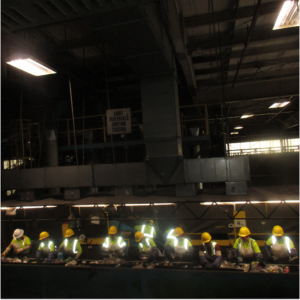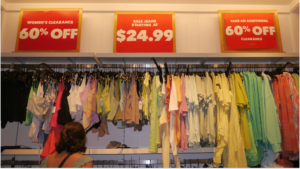17 year-old Shriya Kalluri explores the link between social media and fast-fashion

January 26, 2024
The rise of careless consumerism among young people
Across the world, more and more clothing companies are manufacturing clothes for cheaper, using low cost labor and inexpensive materials.
Not only does this often mean clothes are less durable and short-lasting, but it is contributing to the belief that our clothes are temporary and easily replaceable.
This is resulting in trends and styles cycling faster than ever before with clothing living extremely short life spans, leading to tremendous amounts of waste and pollution.
Often, companies advertise their changing inventories through social media platforms such as Instagram or Tik Tok, emphasizing the popularity of the products they sell.
More than a quarter of Instagram’s users are between 18 and 24 years old , and with posts such as the one below constantly being recommended to young adults, it is extremely easy to feel pressured into unnecessary purchases.
With the growing popularity of social media also comes the growing influence of content creators on these platforms, there are countless videos uploaded on YouTube of content creators documenting themselves buying or updating their “dream wardrobe.”
Encouraging users to do the same, influencers often spend hundreds of dollars on trendy styles from low quality, fast fashion brands such as the popular brand Shein, which has been suspected of both intellectual property theft and the violation of labor laws.
The popularity of these videos highlights how easily influenced the public is through social media, which can be dangerous when considering the ethical issues and tremendous environmental impact behind such rapid consumerism, especially through fast fashion.
The growing convenience of online shopping makes it incredibly easy to spend money without considering the impacts of the purchase, simply because the product is cheap and brings momentary happiness.
However, once a trend begins to fade out it ends up on the clearance rack, and if it still doesn’t sell it is often discarded. Many of the items pictured above listed for 60% off reflect the quickly passed trends, no longer in style.
The closet shown is not unlike many others across the world, stuffed to the brim with clothes the owner no longer wears, often with a garbage bag of out of style clothes ready to be donated or thrown out.
The increasingly poor quality and quick datedness of fast fashion means this is the reality for most consumers, simply because it is near impossible to dress in clothes that are both durable and trendy, supporting an unsustainable industry.
In the end, the vast majority of clothing ends up in waste management facilities to be sorted and discarded.
However, cheaper synthetic fabrics are gaining popularity, making many articles of clothing not biodegradable, in contrast to fabrics such as cotton.
Additionally, articles of clothing made of multiple materials are often difficult, sometimes even impossible to recycle, and must go through chemical-heavy processes to separate the materials.

This rapid consumerism fueled by extremely quick trend cycles and prioritizing ease over impact has had extremely detrimental impacts on our environment, with 92 million tons of clothing waste ending up in landfills each year.
While it is important to note that many low-income buyers often don’t have a more sustainable option than fast fashion, those who can avoid fast fashion must do so.
For instance, influencers who can easily afford to shop at more sustainable options, yet still choose to spend hundreds of dollars on fast fashion influence their young, impressionable target audience of primarily teenagers to do the same.
This encourages quick spending without considering the environmental and ethical consequences.









